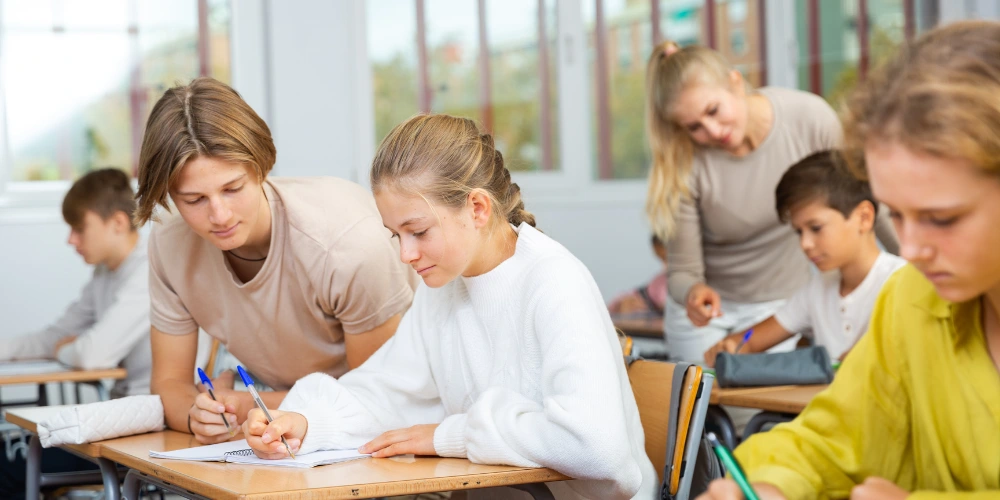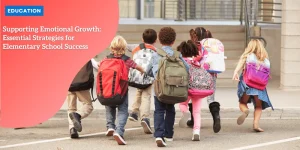Record-Breaking Achievement Gap: How Math Skills Are Dividing America’s 8th Graders
The Widening Math Achievement Gap
The data is clear: the gap in math achievement among America’s 8th graders has never been wider.
Anúncios
This historic disparity reveals a significant divide between high-performing students and their lower-performing peers.
While some students have shown improvement, others are lagging further behind.
Historic Achievement Gap
The latest National Assessment of Educational Progress (NAEP) results are alarming.
Anúncios
High-performing 8th graders have continued to improve, widening the gap with their struggling classmates more than ever before.
These top performers are excelling despite the challenges presented by the pandemic, but many of their peers are not experiencing the same gains.
 Gap in the 8th grade
Gap in the 8th grade
Declining National Math Scores
On a national scale, math scores have dropped overall compared to pre-pandemic levels.
Anúncios
The disruption caused by COVID-19 has had a lasting impact on student learning, with 8th graders scoring an average of 8 points lower than they did before the world was turned upside down.
This decline underscores the critical need to address the educational setbacks exacerbated by the pandemic.
Divergence in Performance
The diverging trends among students are troubling.
While high achievers continue to excel, the progress of lower-performing students has stalled or even reversed.
This growing disparity presents a daunting challenge for educators and policymakers who are striving to provide equitable learning opportunities for all students.
This situation isn’t just a crisis of numbers but a call to action to bridge this growing chasm.
To move forward, we must focus on tailored interventions and equitable strategies to ensure all students have the support they need to succeed.
Post-Pandemic Learning Challenges
The COVID-19 pandemic has inflicted lasting damage on student learning nationwide, with fourth and eighth graders notably suffering.
The effects are stark, as data reveals significant drops in academic performance across the United States.
Lower Scores for Fourth and Eighth Graders
Fourth graders scored, on average, three points lower on their math tests compared to pre-pandemic levels.
This decline is concerning, but the situation is grimmer for eighth graders, who experienced an eight-point drop in average scores.
These numbers reflect profound struggles in adapting to disrupted learning environments that continue to impede academic progress.
Ongoing Impact of Pandemic Disruptions
Pandemic-related disruptions, including remote learning and prolonged school closures, have played a significant role in the observed decline in math achievement.
Students faced numerous challenges adapting to online classes, which often lacked the structure and personal interaction of traditional classrooms.
This shift negatively impacted their learning experiences and overall engagement:
- Higher rates of absenteeism, particularly among lower-performing students
- A notable reduction in student engagement in learning activities
- Changes in learning dynamics and limited access to resources during remote education
These disruptions are not just transient setbacks; their effects ripple through student progress, making recovery an uphill battle.
A Sobering Yet Hopeful Outlook
Looking at these scores can be disheartening, as they reveal areas where students, particularly those already struggling, have fallen further behind.
However, education experts emphasize that “hope is not lost.”
The need for targeted interventions and innovative strategies is clearer than ever.
Addressing these challenges requires a concerted, focused effort to mitigate the educational setbacks experienced during the pandemic, ensuring that all students have equitable opportunities to succeed.
As we move forward, it’s essential to develop and implement strategies that help bridge this widening achievement gap.
By continuously examining and refining approaches, we can work towards improving educational outcomes for all students, even amid lingering post-pandemic challenges.
Contributing Factors to the Decline
The pandemic has undeniably impacted student performance, with various factors contributing to the observed declines in academic achievement, particularly in mathematics.
Higher Rates of Absenteeism
Absenteeism has seen a sharp increase, particularly among lower-performing students.
When students miss school frequently, they fall behind in their studies, often struggling to catch up with the curriculum.
This was observed during the pandemic, as many students faced unprecedented disruptions at home, leading to sporadic attendance and a corresponding drop in academic performance.
Reduced Student Engagement
Engagement plays a critical role in student learning.
However, during the pandemic, reduced student engagement became a prevalent issue.
The shift to remote learning meant that students were no longer part of a structured classroom environment.
Many struggled with the lack of in-person interaction, which is essential for maintaining focus and motivation.
The switch to digital platforms proved challenging for those who found it hard to adapt, leading to a decline in active participation and a disinterest in learning activities.
The Impact of Remote Learning and School Closures
The swift transition to remote learning and prolonged school closures imposed significant hurdles.
Although necessary for health and safety, these measures resulted in a loss of learning time that was difficult to recover.
Students experienced varied access to technology and internet connectivity, leading to inequities in learning opportunities.
In-person instruction provides a level of support and engagement that is hard to replicate in a virtual setting, making it difficult for many students, especially those already at risk, to thrive academically.
Moving Forward with Renewal
Addressing these contributory factors is crucial to reversing the negative trends observed.
By understanding the obstacles faced, educational stakeholders can develop targeted strategies and interventions to support struggling students, improve engagement, and mitigate the impacts of absenteeism.
Every effort should be made to provide comprehensive support systems to foster an environment conducive to learning and growth.
These considerations are foundational as we navigate ways to address the broader, more complex challenges in education, aiming to close the achievement gap and ensure all students have the opportunity to succeed.
Bright Spots and Hope for Improvement
Despite the pandemic-induced setbacks, some positive trends offer a glimmer of hope for the future of education in the United States.
In particular, several states have shown notable improvements, reflecting the resilience and potential of American students.
Louisiana’s Fourth Graders Show Gains in Reading
Contrary to the overarching trend of declining scores, fourth graders in Louisiana demonstrated improved reading abilities compared to pre-pandemic levels.
This is a significant achievement, signaling that targeted interventions and a strong educational framework can positively impact student performance.
The improvement in Louisiana’s reading scores could serve as a model for other states grappling with reading challenges among younger students.
Alabama’s Math Performance Breakthrough
Alabama is another state where educational progress defies the national trend.
Fourth graders in Alabama scored higher in math than they did before the COVID-19 pandemic.
This improvement highlights the success of state-specific educational strategies and reinforces the potential for recovery in mathematics education.
By analyzing and replicating Alabama’s approach, other states can glean valuable insights to bolster their math programs.
Signs of Recovery in Specific Student Groups
The data also indicate some student groups across the country beginning to regain their footing in math.
High-performing eighth graders have continued to show improvements, contributing to the achievement gap.
However, their progress underscores the importance of providing differentiated support to ensure all students can thrive.
Focusing on and expanding these bright spots can provide actionable strategies to help mitigate the achievement gaps caused by the pandemic.
Addressing the complex challenges of the educational landscape will require a multi-faceted approach that includes targeted support for struggling students, innovative teaching methods, and state-specific initiatives that take into account local needs and contexts.
Moving Forward: Addressing the Division
The post-pandemic period has left a significant challenge in its wake—how do we address the growing math achievement gap?
With high-performing students making strides while their peers lag behind, it’s crucial to pinpoint effective strategies for bridging this widening divide.
Need for Targeted Interventions
First and foremost, targeted interventions for struggling students are essential.
These interventions should be personalized to address the specific needs of lower-performing students.
Programs that offer additional tutoring, after-school learning opportunities, and summer schooling can help close the gap.
Targeted support should also focus on the social-emotional needs of students, as emotional well-being is directly linked to academic success.
Importance of Addressing Complex Challenges
Addressing educational setbacks is no straightforward task.
The challenges are complex and multifaceted, incorporating issues such as increased absenteeism, reduced engagement, and the lingering effects of remote learning.
Developing solutions must involve educators, parents, and policymakers working together.
For example, re-engaging students by integrating more interactive and practical math activities can spark interest and a deeper understanding of the subject.
Strategies for Closing the Achievement Gap
Several strategies can help in narrowing the achievement gap:
- Differentiated Instruction: Tailoring teaching methods to fit varied learning needs ensures that all students can grasp the material.
- Enhanced Teacher Training: Providing teachers with professional development opportunities to learn effective instructional strategies can make a significant impact.
- Parental Involvement: Encouraging parents to participate in their child’s learning process helps reinforce skills and concepts outside the classroom.
- Utilizing Technology: Online resources and educational apps can provide additional practice and a fun way to learn math concepts.
- Data-Driven Approaches: Using data to track student progress and adjust instruction accordingly can lead to more targeted and effective teaching.
Positive outcomes in states like Louisiana and Alabama show that recovery is possible with the right interventions.
Academic performance improvements in these areas suggest that applying diverse and targeted strategies can overcome even the most challenging setbacks.
By focusing on these areas, schools can create an equitable learning environment where every student has the opportunity to succeed.





